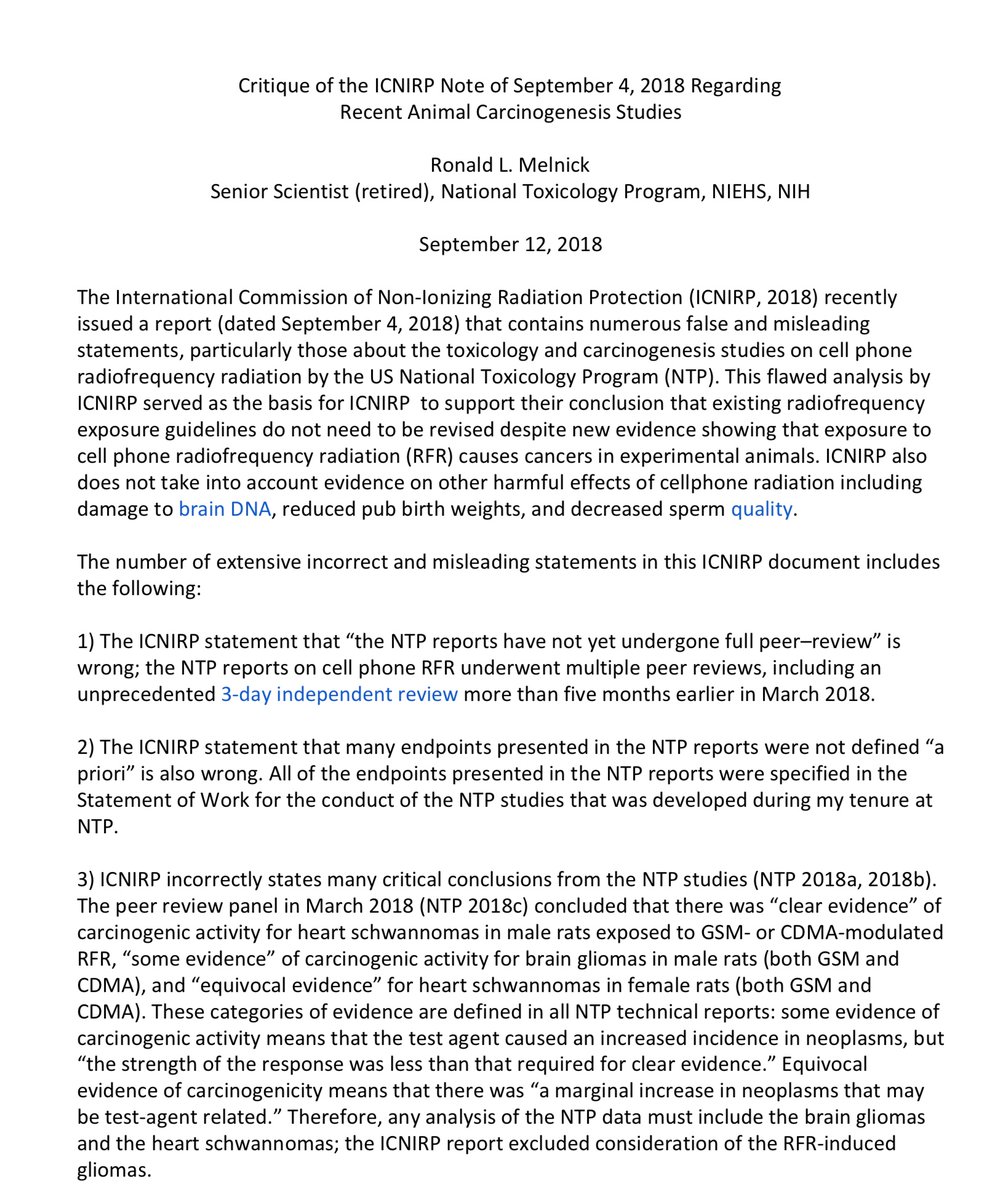
Ron Melnick (who designed the NTP cell phone study):
15 “extensive and misleading statements” made by ICNIRP on the NTP and Ramazzini RF – cancer studies:

See the rest at the link below. We wish to point out number 7:
Criticism by ICNIRP concerning the consistency between the NTP studies (NTP 2018a) and the Ramazzini study (Falcioni et al., 2018) is disingenuous. The fact that both studies carried out in independent laboratories in Italy and the U.S. found increased incidences of heart schwannomas and Schwann cell hyperplasias in Sprague-Dawley rats under different exposure environments and different RF intensity levels is remarkable. Without knowledge or analysis of the true dose-response relationship between RFR exposure and the induction of schwannomas and Schwann cell hyperplasias of the heart, it is unreasonable to expect a linear dose-response by combining data from these two separate studies. Link below:
Fiorella Belpoggi of the Ramazzini Institute in Italy responds to the ICNIRP:
Studies of the Ramazzinini Institute and the U.S. NTP will “certainly contribute” to the evidence that IARC and other agencies can use to re- evaluate RF cancer risks:
Comments on the ICNIRP evaluation on the NTP and Ramazzini Institute studies:
- For sure both NTP and RI studies were well performed, no bias affecting the results. ICNIRP confirms that.
- Shwannomas are tumors arising from the Schwann cells, they are peripheral glial cells which cover and protect the surface of all nerves diffused throughout the body; so vestibular (acoustic nerve) and heart schwannomas have the same tissue of origin: ICNIRP seems to ignore that;
- In rats, increases in malignant heart schwannomas, malignant glial tumors of the brain and Schwann Cells Hyperplasia (a pre-malignant lesion) are rare yet these lesions were observed in exposed animals of both laboratories, at thousands of kilometers distance, in a wide range of RFR exposures studied. These findings could not be interpreted as occurring “by chance”.
- We are scientists, our role is to produce solid evidence for hazard and risk assessment. Underestimating the evidence from carcinogen bioassays and delays in regulation have already proven many times to have severe consequences, as in the case of asbestos, smoking and vynil chloride. This position of ICNIRP represents its own responsibility toward citizens and public health.
- ICNIRP is not a public health agency that routinely evaluates carcinogens. On the other hand, an independent agency that has evaluated over 1000 agents, IARC, as early as 2013 classified RFR as a possible carcinogen on the basis of limited evidence in humans and limited evidence in animals. The studies of the RI and NTP will certainly contribute to the burden of evidence that IARC and other public health agencies can draw upon as a solid base for the re-evaluation of RFR carcinogenicity.
Onde elettromagnetiche, l’Istituto Ramazzini risponde all’ICNIRP
In a new paper, “Clear evidence of cell-phone RF radiation cancer risk” published in the journal IEEE Microwave Magazine, Dr. James C. Lin states that the results of the National Toxicology Program (NTP) cell phone radiation study suggest that current radio frequency (RF) exposure guidelines are inadequate to protect human health (1). Furthermore, the paper recommends that the International Agency for Research on Cancer (IARC) re-assess the research and consider upgrading the classification of RF radiation from “possibly carcinogenic to humans” (Group 2B) to probably carcinogenic (i.e., Group 2A).
Based on the evidence reviewed it is our opinion that IARC’s current categorization of RFR as a possible human carcinogen (Group 2B) should be upgraded to Carcinogenic to Humans (Group 1). https://www.sciencedirect.com/science/article/pii/S0013935118303475
Revision of current guidelines for exposure to RF radiation is needed. Evaluation of Mobile Phone and Cordless Phone Use and Glioma Risk Using the Bradford Hill Viewpoints from 1965 on
Association or Causation c64ddeec4cc9613516a37c8a3ddeeb83f4e7
